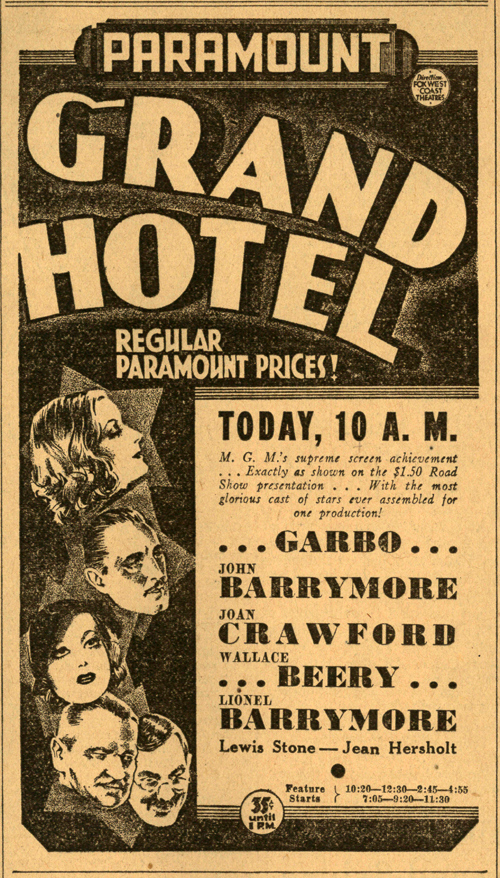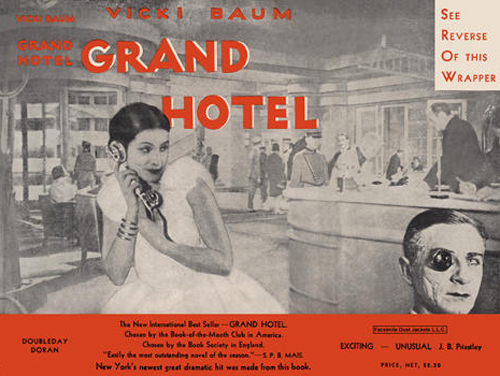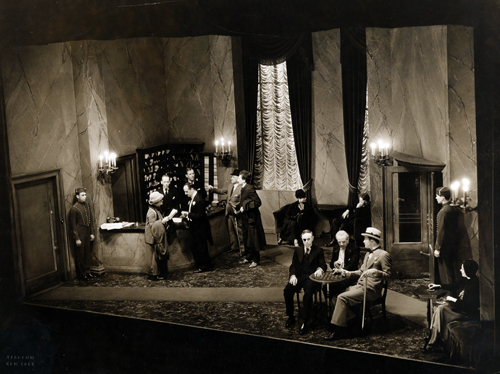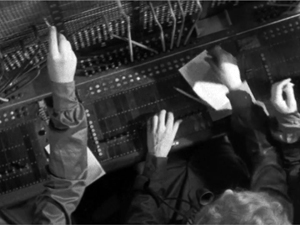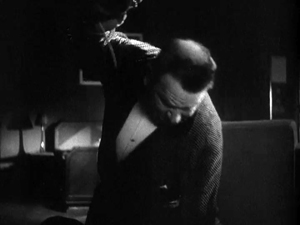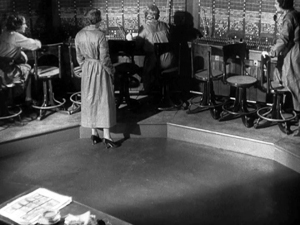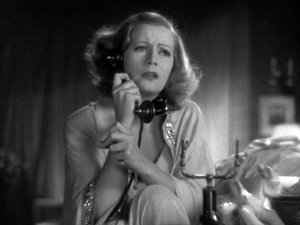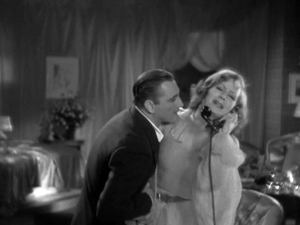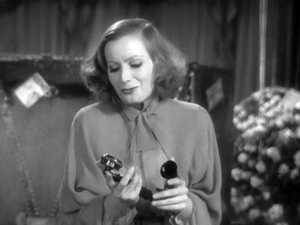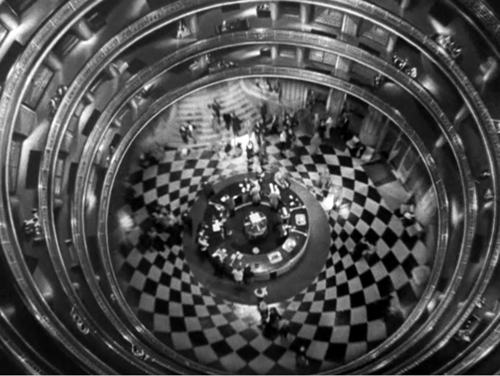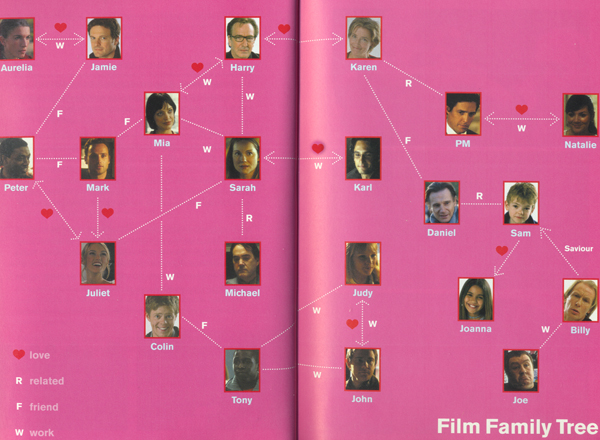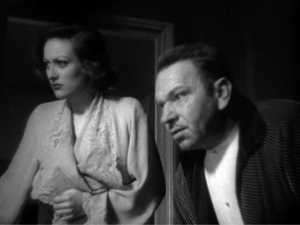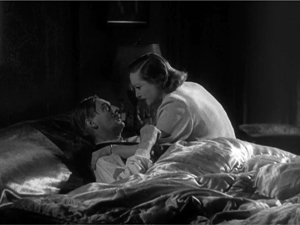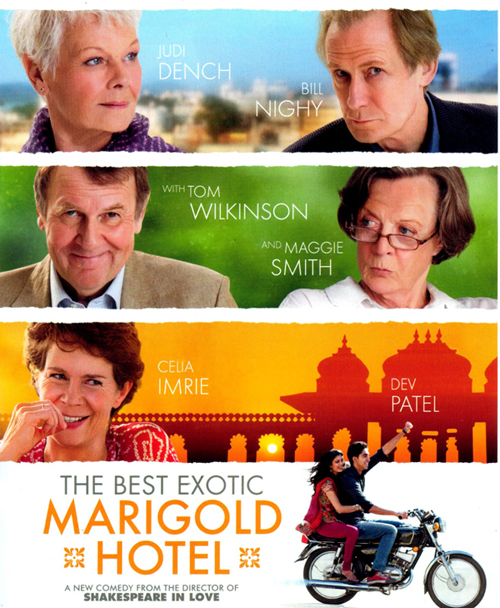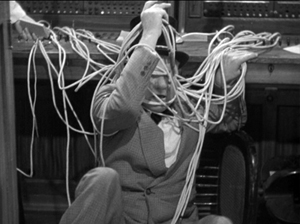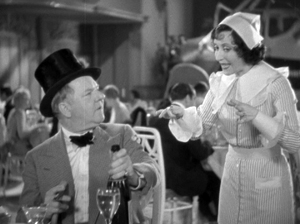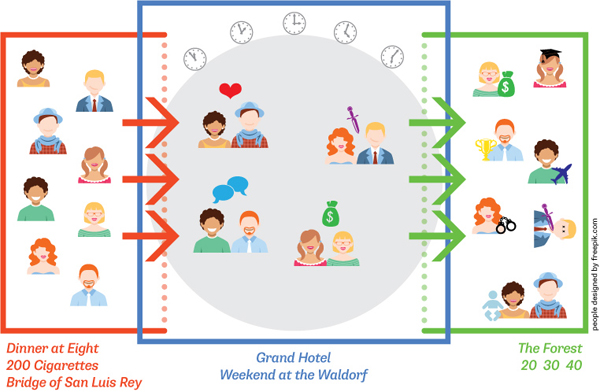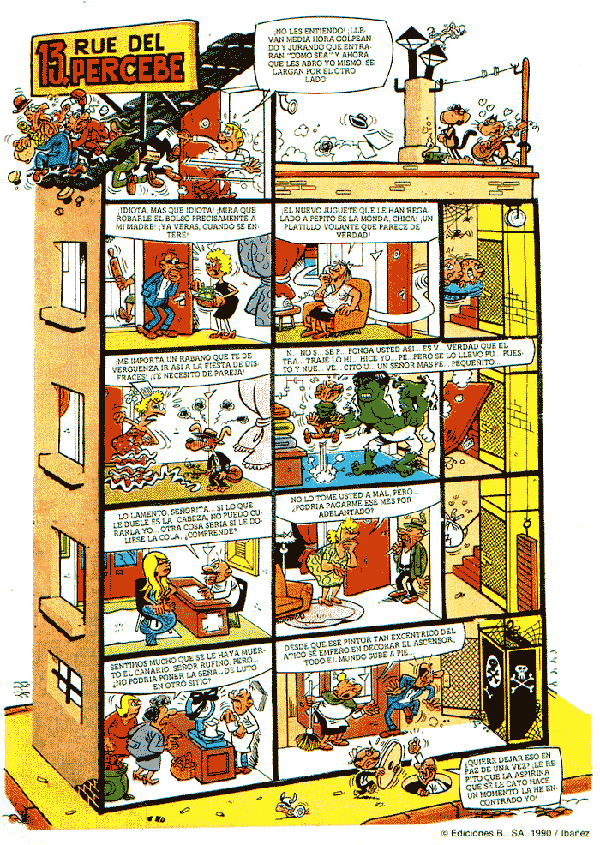1932: MGM invents the future (Part 2)
Sunday | March 22, 2015 open printable version
open printable version
Courtesy John McElwee and his gorgeous, informative site Greenbriar Picture Shows.
DB here:
The inner monologue, as a report of a character’s immediate thoughts, seems to have been rare in 1930s films; it became more prominent in the 1940s. But the second big MGM narrative innovation of 1932 was almost instantly influential, redone and nearly done to death in the decades that followed. Even before the film was released, the idea of a “Grand Hotel plot” had gripped both the public and professional storytellers. And it never went away.
In the Strange Interlude entry, I mentioned that what’s usually of interest to us when we try to track the history of film forms is not the first time something is done but the moment when it becomes recognized as an active option. It stands forth as a strategy that can be copied, standardized, and revised. The Grand Hotel idea itself wasn’t utterly new, but the novel, play, and film of that title crystallized it as a distinct choice on the filmmaking menu.
The book: Only approximations
Vicki Baum, an emerging German novelist, launched Grand Hotel as a magazine serial. It was published in book form in 1929 as Menschen im Hotel and became a huge seller. The following year saw Baum’s international breakthrough. In January a stage version opened in Berlin. It migrated to Broadway in November and enjoyed huge success. Meanwhile, a British publisher brought out an English translation. In February of 1931, Doubleday published an American edition. That month Baum arrived in Hollywood to work on the screenplay for what she called her “star-studded wedding cake.”
The central story remains constant in all the media versions. Three men converge in Berlin’s Grand Hotel, each with his own aims. Baron von Gaigern is a penniless aristocrat who has taken to theft. The provincial bookeeper Kringelein has been diagnosed with a fatal disease, so he has vowed to enjoy the good life before he dies. He demands a costly room and plans to wine, dine, and gamble his savings away. The business mogul Preysing is there to meet with potential partners in a big business deal. Preysing, it turns out, is the owner of the company employing Kringelein.
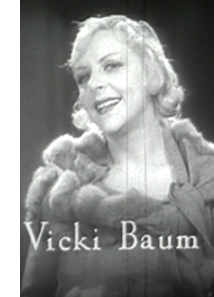 The men’s plans pull two women into their orbit. There is the glamorous but fading dancer Grusinskaya. She meets the Baron when he slips into her room to steal her pearls; during that night of sexytime they fall in love. Then there is the stenographer Flaemmchen, who takes a liking to the Baron but who is dominated by Preysing. He has hired her to record his deal-making, and he soon invites her to be his mistress. Add in secondary characters like the porter Senf, who at the start is waiting for news of his wife’s delivery of their baby, and Dr. Otternschlag, a disfigured war veteran who drifts around the lobby mournfully observing life.
The men’s plans pull two women into their orbit. There is the glamorous but fading dancer Grusinskaya. She meets the Baron when he slips into her room to steal her pearls; during that night of sexytime they fall in love. Then there is the stenographer Flaemmchen, who takes a liking to the Baron but who is dominated by Preysing. He has hired her to record his deal-making, and he soon invites her to be his mistress. Add in secondary characters like the porter Senf, who at the start is waiting for news of his wife’s delivery of their baby, and Dr. Otternschlag, a disfigured war veteran who drifts around the lobby mournfully observing life.
The novel’s action consumes three days and nights, with an epilogue on the morning of the fourth day. Each major character undergoes a crisis triggered by meeting others in the hotel. Preysing catches the Baron in his apartment, bent on robbery. In beating the Baron to death, Preysing ruins his life; he is arrested and his family leaves him. Flaemmchen, about to go off with Preysing, attaches herself to Kringelein and vows to help him recover his health. Grusinskaya, who has left Berlin for her tour date in Prague, calls the Baron’s room in vain, unaware that she will never see him again.
The book offers several attitudes toward the interwoven destinies. There is that of the grim Dr. Otternschlag, who sees in the lobby’s revolving door a ceaseless cycle of mundane suffering. “Always the same. Nothing happens. . . . And so it goes on. In—out, in—out.”
The bellboy looks at the same door and sees endless variety: “Marvelous the life you see in a big hotel like this. . . . Always something going on. One man goes to prison, another gets killed. . . .Such is Life!”
The omniscient narration provides another attitude, seeing in the door an image of life’s ephemeral, fragmentary quality.
The revolving door twirls around and what passes between arrival and departure is nothing complete in itself. Perhaps there is no such thing as a completed destiny in the world, but only approximations, beginnings that come to no conclusion or conclusions that have no beginnings.
All three musings represent, we might say, alternative ways of reading the novel: as an eternal return, a varied pageant of human drama, or scattered glimpses of incomplete lives.
Play and film: Call waiting
National Theatre production, New York 1930.
The novel spreads the action to the theatre, a casino, and an airplane flight, but the stage version confines itself wholly to the hotel. The play begins with a coup de théâtre for which Baum claimed the credit. Preysing, Kringelein, the Baron, Flaemmchen, and Grusinskaya’s maid Suzanne are introduced in a line of telephone booths, each making a quick phone call. The light in each booth flashes on and off as each one speaks. The pace builds until each speaker is “intercut” rapidly with another. Baum claimed that this pulsating sequence drove the opening-night audience to a frenzy of applause. Snazzy as it is, the prologue serves as crisp exposition, literally spotlighting nearly every major character, with Suzanne acting as a proxy for the dancer Grusinskaya. Then the revolving stage whisks us to a broad view of the lobby teeming with guests and staff.
The novel can proceed in a fragmentary way, shifting from one character to another, but the play contrives a more fluid rhythm of encounters. At the start, several characters assemble at the front desk, and after a “cutaway” to Grusinskaya’s room, we’re back in the lobby with Flaemmchen, the Baron, and Kringelein chatting while Preysing and his colleagues head off to their conference. Later all the major characters except Grusinskaya, who’s often marked as separate from the others, meet in the hotel bar and grill. At the conclusion, as characters depart, overlapping encounters carry Flaemmchen out the door with Kringelein, and Grusinskaya leaves for Prague wondering why the Baron has failed to meet her. The spatial concentration of the play squeezes the characters’ trajectories together more tightly than the novel does.
The film does much the same thing. When head of production Irving Thalberg bought the rights to Baum’s novel, he had to buy the stage rights as well, and so MGM funded the Broadway production. It garnered over a million dollars in its first year.
Claus Tieber points out that having seen the play, Thalberg insisted that the bits that pleased the Broadway audience had to stay in the film. No wonder that the film sticks close to the stage version. Although sequences are added, they seem in the spirit of the play’s swift pace. An American critic had described the book’s rapid changes of scene as like a film: “interlocking adventures, a little too easily linked perhaps, flit from screen to screen [shot to shot?].” Baum agreed:
I realized what had made my Grand Hotel, the novel and the play, a world success: it was probably the first of its kind to be written in a sort of moving picture technique. By now [1964] that’s the oldest of old hats, but in those days the kaleidoscopic effects, brief ever-changing scenes, flashes, staccato dialogue, were new, surprising, and exciting…on the stage. On the screen, I felt, this technique was the usual old stale shopworn thing.
In a crucial expansion of both book and stage show, the film emphasizes the telephone switchboard, marking the hotel as the crossing point of many destinies. After Preysing has beaten the Baron to death with a phone receiver, the switchboard is ominously stilled at the climax.
The prologue shows other protagonists making calls, but Grusinskaya, because of her isolation from the others, works the phone in the bulk of the film. Her final call for the Baron goes unanswered, heard only by his dog.
The play had enhanced the women’s roles, and the film goes farther by casting two top stars, Greta Garbo as Grusinskaya and Joan Crawford as Flaemmchen. With three strong male leads—Wallace Beery as Preysing, Lionel Barrymore as Kringelein, and John Barrymore as the Baron—the film became an ensemble drama that gave more or less equal weight to five characters. Accordingly it became known as the first “all-star picture.” On its tenth anniversary Variety proclaimed that it “disproved the contention that no picture could support a huge all-star cast.”
Even putting the cast aside, Grand Hotel crystallized a narrative option that had been emerging, more or less explicitly in the years before.
Networks and cross-sections
We can think of the Grand Hotel format as one variant of what I’ve called network narratives. Putting it generally, these are films that shift our attention across several somewhat linked characters and their projects.
Most films we encounter have a single protagonist, accompanied by helpers and facing some number of antagonists. Other plots have dual protagonists, perhaps cops who are buddies, or a man and a woman in a romantic relationship. A few films may have three protagonists, like Letter to Three Wives.
Another variation is the film with several protagonists, each given roughly equal weight. Usually the multiple protagonists share a goal, as in combat films, where they are united in a common mission. But when we have multiple protagonists pursuing different, largely unrelated goals, we have what I’m calling a network narrative.
What makes all these characters part of the same network? Any social relation. They might be relatives, friends, co-workers, classmates, neighbors, ex-lovers, or whatever. Also, mere proximity can connect characters; maybe they’re in the same hospital room or conference meeting or just in the same town.
As the film unfolds, we come to understand the array of characters and their connections. We follow one, then another, and we watch new relationships form. Sometimes hidden relationships are revealed to create a surprise. Some connections are distant, of the n-degrees-of-separation variety. The characters’ various purposes may run parallel, or they may intersect and clash—all more or less accidentally. Most plots of any sort are connected by causality, but network narratives are once tight (because of the pressure of the characters’ goals) and loose (because social ties can flow in many directions).
The advantage of the network approach is to yield a cross-section of life denied to more traditional linear narrative. Such plots can present, as Joseph Warren Beach puts it, a “comprehensiveness of view” that becomes “a composite picture of many distinct lives.” But the strategy raises problems too. The idea of a network narrative invites a dizzying expansion. X meets Y, who’s married to Z, the friend of A, who works with B, and pretty soon your story world is growing out of control. You need to constrain it somehow.
One way, as in Slacker, is just to sample one string of the network, moving from node to node. This generates a sort of “slice of life” plot, in the manner of Naturalist theatre. That snatches a few episodes from central characters’ lives without the customary setups and resolution. Bernard Shaw noted that “The moment the dramatist gives up accidents and catastrophes, and takes ‘slices of life’ as his material, he finds himself committed to plays that have no endings.” In film, we might think of one prototype of Neorealist cinema, The Bicycle Thieves. Baum’s framing narration of Grand Hotel, with its musing on stories without clear-cut beginnings or resolutions, tries for the same sense of what Zola called “a fragment of existence.”
Some of the literary models, such as The Lower Depths, accept a slice-of-life approach, without traditional climaxes and resolutions. Modernist writers pushed this possibility further, very open-textured networks. Dos Passos’ USA trilogy (1930-1936) is one example. Evelyn Scott’s The Wave (1929) presents seventy episodes from the Civil War, each concentrating on a different individual, although some characters reappear in sections devoted to others. A comparable strategy rules William March’s Company K (1933), with its 131 vignettes of World War I, with each soldier’s scene narrated in first person. Again, some characters reappear, but the network is largely a dispersed one.
Novels with well-defined protagonists occasionally strayed into a more lateral, open-textured approach. One example is the Wandering Rocks section of Ulysses, which fleetingly probes the minds and actions of about a hundred Dubliners moving through mid-afternoon. In Woolf’s Mrs. Dalloway (1925), a sudden noise from a car stuck in traffic, followed by an airplane swooping above, causes various members of a crowd to think stray thoughts. Like Joyce, Woolf momentarily broadens the frame to register the reactions of characters unconnected with the protagonists, except by being present outside Buckingham Palace at the same moment. Only space and time create this network, and it’s ephemeral.
Bring us together
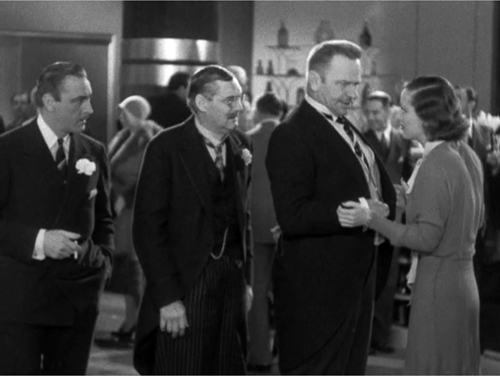
Given our appetite for linear narrative, some storytellers are bound to seek ways to tighten things up. Can we graft normal plot development—goals, conflicts, rising tension, climaxes, and resolutions—onto the network idea?
Yes. One way is to create the network through a circulating object, as in Tales of Manhattan, Au hasard Balthasar, American Gun, Twenty Bucks, or The Earrings of Madam de…. Sometimes the result will be episodic, but other times there will be a rising tension and a conclusion to at least some lines of action.
The most common way to constrain the network is to multiply the connections within the group. That is, don’t make the network loosely woven. So X meets Y, who’s married to Z, the friend of A; but A works with X, who is the cousin of B, who has been having an affair with Y, and so on. In other words, you create a “small world” defined by several connections among all the participants.
This small-word model is common in novels that create network narratives. Dickens, Balzac, and other writers have created complex degrees-of-separation plots. It’s likewise the pattern for most network narratives on film: several connections link many of the nodes. Here’s a diagram for Love Actually.
This chart is oversimplified because it doesn’t account for other relationships. Colin, for example, as the sandwich delivery boy, interacts with several of Harry’s employees. Still, at a glance you can see a fairly tight network.
Another way to constrain the network is to set limits of space and time. Slacker, like Mrs. Dalloway, explores a network established by spatial proximity; when we leave one character we pick up another nearby. The circulating-object option often presumes that the characters share a locale. Love Actually limits its intertwined stories to London, and still further to the Christmas season there. Louis Bromfield’s 1932 novel Twenty-Four Hours follows its Manhattan ensemble through one full day. (Compare that unlamented recent release, Valentine’s Day.) A 1938 British film, Bank Holiday traces several people across a weekend at a seaside resort.
The space can be more radically limited, as in Waldo Frank’s book of interconnected short stories City Block (1922). Perhaps influenced by Frank’s book, Elmer Rice wrote and staged Street Scene, a 1929 play that weaves together the lives of people living in a tenement. Their relationships are played out on the building stoop and the street in front. The play was filmed in 1931, and perhaps if it had been more successful, or had featured many big stars, we’d be talking about “Street Scene plots” rather than Grand Hotel ones.
Buildings are ideal for tying story lines together. Zola’s novel Pot-Bouille (1882) confines its action largely to an apartment house and the people who live there. Gorky’s play The Lower Depths brings together several characters in a flophouse. Inns, taverns, and hotels are natural points of convergence, and travelers naturally bring story action along with them. This is the narrative convention of l’auberge espagnole, based on the idea that in a Spanish inn you bring your own food.
When we have mostly strangers interacting in a constrained time and space, and when those interactions lead to traditional conflicts and resolutions (avoiding the slice-of-life pattern), we can speak of “converging-fates” narratives. Grand Hotel became the great prototype of converging-fates plotting.
Baum modernized the auberge espagnole idea by concentrating the action in a luxury hotel. She understood that these surroundings could motivate the chance meetings that propel the plot. She wasn’t alone. At the time her book was published, there were other “hotel” novels, notably Arnold Bennett’s Imperial Palace (1930). Whereas Bennett emphasizes the hotel staff and its routines, Baum concentrates on the guests. She motivates her comparisons across classes by making Kringelein a poor man having a final fling and making the Baron a penniless aristocrat keeping up appearances.
Baum showed how filmmakers who wanted an ensemble plot could bypass the sort of fragmentary, open-textured network seen in Dos Passos, The Wave, or Company K. She showed how to build more tightly integrated situations, with intersecting characters, each pursuing his or her goals and unexpectedly affecting other characters. The whole dynamic would take place in a rigorously confined setting and a sharply bounded period of time. The disparate story lines, knotting in certain scenes, would build to a climax. In Grand Hotel, all the characters’ fates come together when Preysing kills the Baron. Flaemmchen, terrified, rouses Kringelein and brings him into the crisis.
In such ways, a network narrative could become a variant of classical plotting, complete with exposition, conflict, crisis, and climax. Now Baum’s claim that the book traces mere fragments of life seems to be camouflage. Each protagonist’s fate has a linear logic; it’s just that the lines intersect.
If you’re a modernist, you find this a dilution of strong brew. You deplore the way fiction writers and moviemakers adapt avant-garde techniques to middlebrow taste. Yet if you’re a mainstream filmmaker, you can see that absorbing these techniques freshens up the norms. The crisscrossing destinies create an urgent pace, a new openness to chance and accident, and an invitation to imagine a patterning beyond that of straightforward single- or dual-protagonist plotting. Hollywood may feed on more “advanced” storytelling, but it doesn’t simply iron out the difficulties; in absorbing the techniques, it enriches its own traditions.
Thalberg predicted this change when the film was in production.
I don’t mean that the exact theme of “Grand Hotel” will be copied, though this may happen, but the form and mood will be followed. For instance, we may have such settings as a train, where all the action happens in a journey from one city to another; or action that takes place during the time a boat sails from one harbor and culminates with the end of the trip. The general idea will be that of a drama induced by the chance meeting of a group of conflicting and interesting personalities.
The last sentence isn’t a bad encapsulation of the converging-fates schema.
Hotel franchising
Thalberg was right, of course. Grand Hotel, in all its incarnations, encapsulated a narrative option that was irresistible. By 1955 Kenneth Tynan paid tribute to the fertility of the idea.
No literary device in this century has earned so much for so many people. Unite a group of people in artificial surroundings—a hotel, a life-boat, an airliner—and, almost automatically, you have a success on your hands.
Baum compared herself to the sorceror’s apprentice, who couldn’t stop her creature from splitting and rushing off in all directions. Critics detected traces of the novel and play in Translatlantic (1931), Union Depot (1932), and Hotel Continental (1932), all released before the MGM vehicle. These films do confine most of their action to a single setting, but they don’t multiply protagonists to the same extent as the original. A 1932 play, Life Begins, is closer to Baum’s model, finding converging destinies in a maternity ward. Some suspected that the 1932 film, released in May, was Warners’ effort to compete with Grand Hotel, premiering in April but not going wide until summer and fall.
MGM imitated itself in another 1932 release, Skyscraper Souls, which applied the formula to an office building. Faith Baldwin’s original novel Skyscraper focused on a working-girl romance, but the screenplay expanded the plot. A great many characters working in the skyscraper get involved in love affairs, a stock swindle, and an aborted jewelry theft. As with Grand Hotel, all the action transpires in one building.
Like Strange Interlude, Grand Hotel inspired parody. In Paramount’s International House (1933) various personalities converge on a hotel in Wu-Hu, China, to buy the rights to Dr. Wong’s “radioscope” (aka TV). W. C. Fields, Stuart Erwin, Bela Lugosi, Franklin Pangborn, Cab Calloway, Rudy Vallee, George and Gracie, and the notoriously torrid Peggy Hopkins Joyce enliven the proceedings. There’s an allusion to the hotel switchboard in the original film when Fields gets tangled up in phone cables. He’s also flummoxed by Gracie Allen.
After one of Gracie’s non sequiturs Fields asks: “What’s the penalty for murder in China?”
A curious parallel surfaced in Die Wunder-bar, a German play premiered in February 1930, just a month after the opening of Grand Hotel’s stage version. Transposed to film, it became an Al Jolson vehicle, Wonder Bar (Warners, 1934). It has a fairly coherent threads-of-destiny plot. Flirtations, suicides, and musical numbers (including one with Al in blackface, of course) fill out action occurring in a single day. There was also Die Uberfahrt, a 1932 novel by Gina Kaus, translated as Luxury Liner and filmed under that title by Paramount in 1933. Variety called Wonder Bar “a ‘Grand Hotel’ of a Paris boite-de-nuit,” and Motion Picture Herald called Luxury Liner “Grand Hotel on a steamboat.”
The Grand-Hotel-on-an-X formula became a catchphrase, like Die-Hard-on-an-X of years later. We associate the phrase “Grand Hotel on wheels” with Stagecoach (1939) because that was used in its publicity. But reviewers had applied that phrase earlier, to Streamline Express (1935) and Time Out for Romance (1937)—the former involving a train, the latter an automobile convoy. The British import Rome Express (1933) was “Grand Hotel on a train” and Mitchell Leisen’s fine Four Hours to Kill (1935), set in a theatre lobby and lounge, became “Grand Hotel in miniature.” Fifty-four Ames Street, a screenplay apparently never filmed, was said to be “a sort of Grand Hotel in a New York apartment house.” Producers interested in Saroyan’s play The Time of Your Life saw in its tavern locale and migrating flocks of characters “an all-star vehicle somewhat along the lines of ‘Grand Hotel.’”
One critic worried that Winter Carnival (1940) was tantamount to “Grand Hotel on skis,” but F. Scott Fitzgerald, sweating over the script, had worried that it couldn’t be “a group picture in the sense that Stagecoach was, or Grand Hotel.” It had, he noted, “no sense of destiny.” That sense was much stronger in One Crowded Night (1940), an RKO B that I’m fond of. It might be called “Grand Motel,” as it brings together a preposterous number of plotlines at a desert auto court.
The Grand Hotel paradigm did not rest. The original film was remade, in more complicated form, as Week-End at the Waldorf (1945). There were other variants of the template—famously Lifeboat (1943) and Hotel Berlin (1945), less notably Ulmer’s Club Havana (1945) and the PRC cheapie The Black Raven (1943). Life Begins was redone as A Child Is Born (1940), and at the end of the decade Harry Cohn expressed interest in remaking it again. The play Flight to the West (1940), set on an airplane, showed Elmer Rice contributing to the trend.
By 1943, a Variety columnist was admitting that there was a tradition behind it all. “Ever since Boccaccio rounded up a herd of characters in his Decameron, dramatists have been utilizing the restricted space idea to make their stories more compact.” What he did not say was that most of Grand Hotel knockoff movies had been B-pictures.
Baum bitterly resented what had happened to her most famous work. “Countless cheap imitations and adaptations gave it a bad name. . . It all quickly became a mechanical toy. A formula, to be bought and sold on the supermarket.” That didn’t stop her from ringing changes on her model. Her play Pariser Platz 13 (1930), set in a beauty parlor, and her novel Martin’s Summer (1931), tracing a drama among strangers at a vacation resort, inevitably recalled her breakthrough work. She mined the vein again with Hotel Shanghai ‘37 (1939) and Hotel Berlin ’43 (1944). Things became risible when Variety announced that she was preparing a (never-filmed) screenplay called Grand Central Market, based on an idea by a busboy in the MGM commissary. But perhaps she wouldn’t have minded the jeers that she was milking her most marketable idea. “I know what I’m worth: I am a first-rate second-rate author.”
Catch them coming or going
The Grand Hotel converging-fates format got recycled for decades, in movies from The V.I.P.s and Hotel to Four Rooms and Auberge Espagnole. Network narrative as a general trend came back in a big way in the 1990s. In an essay for Poetics of Cinema, I counted some 148 examples just from the period between 1994 (Pulp Fiction, 71 Fragments of a Chronology of Chance, Ready-to-Wear, Chungking Express, Exotica) and 2006 (Bobby, Colossal Youth, Selon Charlie), by way of Do The Right Thing, Magnolia, Sunshine State, Wonderland, and Happiness. Filmmakers, mostly non-Hollywood ones, revived and reformatted the old template. They could cunningly resolve some story lines, and so satisfying our fondness for closure, while also leaving some unresolved, and so satisfying our belief in realistic “slices of life.”
Although I should be fed up with such plots, I still find them intriguing. They can yield mystery, as we’re teased about the possible connections among the characters; their network pattern can be revealed or obscured by flashbacks, subjective sequences, frame stories, forking-path patterns, and other devices, as in Go and Once Upon a Time in Triad Society 2. The format can really test the ingenuity of a screenwriter.
Still, network plots pose unique problems. One is figuring out all the interactions in situ. How do you weave everything together? Apart from kinship and friendship, the easy links are chance encounters, merely passing in the street, watching somebody on TV, or, most desperate of all, the traffic accident. (Crash is only the most egregious instance.) Finding fresh ways to hook up your nodes is quite a challenge, as is devising a satisfying payoff for at least some of them.
Another problem is more specific to the converging-fates option: the choice of “point of attack.” Taken just as geometry, the plot can be seen as having three phases. Here’s an infographic courtesy of our web tsarina Meg Hamel. On the left, the characters are independent. In the center–a closed environment like a hotel, or a more porous one like a holiday season–they are drawn together. They circulate and interact. On the right, we see them dispersing, all changed in one way or another.
The question is: Where do you cut into this process to start and end your plot? Some films, like In Which We Serve, try to trace the whole process more fully. We see it in a more spacious form in The Great Race and Cannonball Run. Perhaps The Rules of the Game would be another instance.
But most films of this ilk concentrate on the convergence, the central circle of interaction we see in Grand Hotel. That’s what we find in Mizoguchi’s Street of Shame, The Uchoten Hotel, Drive-In, Health, The Yacoubian Building, Monsoon Wedding, et al. Often there’s a time pressure too, as the clocks in the graphic indicate.
Or you the screenwriter could shift a step back and base your plot on the action before the characters commingle. My red block indicates a plot concentrating on this early phase. The dotted line indicates our seeing a little bit of the convergence.
The prototype is probably Dinner at Eight, a 1932 play made into a 1933 film (yes, also by MGM). The comic plot traces several couples invited to a dinner party. Some of them have one-off encounters before the big night, but the plot depends on the eventual convergence of everyone. The film stops just as the assembled guests step into the dining room. A modern parallel is 200 Cigarettes, which intercuts several guests on their way to a party. Again, we don’t see the party directly, but in an epilogue a montage of snapshots gives us some glimpses.
Probably the most famous example of pre-convergence plotting is the novel The Bridge of San Luis Rey. Thornton Wilder uses a flashback construction to trace the lives of the characters. At the start we learn that the bridge collapsed, killing them all, and then via an inquisitive priest we are taken back to the events that brought them to the same fate. By contrast, Claude Lelouche’s Il y a des jours…et des nuits saves the moment of convergence for a traffic tieup at the very end of the film.
Alternatively, you could build your plot at the other end, as indicated by my green box. Your story action begins with the dispersal of the characters who have already converged, though perhaps you show something of their encounters before they split up.
This is the rarest option, I think. One example is Benedict Fliegauf’s The Forest, which shows several people leaving a train station and proceeding on to their parallel, and fairly mysterious, lives. A more heavily motivated example is Sylvia Chang’s film 20 30 40, which initially brings three women together as passengers on an airplane flight before sending each off to her own pursuits. Although they live in the same neighborhood and their activities are intercut, the women never meet. Two films I haven’t seen seem to follow this parallel-dispersal pattern. In Urlaub auf Ehrenwart (Leave on Word of Honor, 1938), a commander gives his men leave for a day on their way to the front, and the plot follows each one’s experiences. It was adapted into a Japanese film, The Last Visit Home (Saigo no kikyo, 1945).
As with any plot scheme, the closer you look, the more variations and extensions you see. Sometimes it’s useful to see any one plot as a reconfiguration of other plots. The network principle–itself a threading of goal orientation, conflict, and other narrative devices–can be a beautiful meeting point of story possibilities. One reason I think filmmakers like these plots is that, somewhat like mystery stories, they are narrative to the nth degree. How many situations, characters, and unexpected connections and analogues can you squeeze into a single movie? It’s a challenge.
What crystallized in an MGM prestige production of 1932 seemed a fresh approach to film narrative. Even in the opportunistic ripoffs of the following decades, we can sense an excitement in tinkering with a new storytelling pattern. And of course some variants still seize us today. Just ask the audience making its way to The Second Best Exotic Marigold Hotel, or the young hipsters immersed in the mini-library that is Chris Ware’s Building Stories. Lately we haven’t seen many network movies, but I expect another wave. Like it or not, some story ideas never die.
My information about Vicki Baum’s career comes from Lynda J. King’s Best-Sellers by Design: Vicki Baum and the House of Ullstein (Wayne State University Press, 1988). I drew my Baum quotations from two curiously different editions of her memoirs, I Know What I’m Worth (Joseph, 1964) and It Was All Quite Different: The Memoirs of Vicki Baum (Funk and Wagnalls, 1964). The reviewer who called Baum’s novel cinematic was Herman Ould in “Experiments in Technique: Vicki Baum and Arnold Zweig,” The Bookman 79 (November 1930), 132.
Claus Tieber analyzes the Grand Hotel story conferences in “‘A story is not a story but a conference’: Story conferences and the classical studio system,” Journal of Screenwriting 5, 2 (2014), 225-237. In correspondence Patrick Keating has shared with me a story conference concerning Skyscraper Souls (MGM, 1932), in which the participants discuss transitions between scenes. Should the film cut from one plotline to another, or use camera movements, or have the characters link to one another? The filmmakers discuss Grand Hotel as a model for handling the problem. Thanks to Patrick for the information.
Joseph Warren Beach provides a helpful survey of experiments in mainstream fiction of this period in The Twentieth Century Novel (Appleton Century Crofts, 1932). I’ve drawn upon his chapter “The Breadthwise Cutting.” Shaw’s remarks on the slice-of-life plot are in his Preface to Three Plays by Brieux (Brentano’s, 1913), xv-xvi. In The Writing of Fiction (Scribners, 1924) Edith Wharton comments that English novelists of the early nineteenth century favored the “double plot,” a form that presented “two parallel series of adventures, in which two separate groups of people were concerned, sometimes with hardly a link between the two” (81). She considers this a “senseless convention,” but it seems to me another means of creating a network narrative. Sometimes the nodes connecting the groups become clear only gradually. There may be even a dose of mystery, as in Our Mutual Friend; the reader is encouraged to wonder how the two ensembles might be hooked up.
The diagram of the network in Love Actually comes from Peter Curtis, Love Actually (St. Martin’s, 2003), 6-7. Although at least one story line in the film doesn’t get fully resolved, Curtis is committed to a classical model: “I thought I’d like to have a go at writing that kind of film–to see if it was possible to write a film with nine beginnings, nine snappy middles and nine ends.” He declared himself inspired by Nashville, which I’d argue has a much looser texture and treats its story lines largely as slices of life.
Kenneth Tynan’s remark comes from his 1955 essay “Thornton Wilder,” reprinted in Profiles, selected and edited by Kathleen Tynan and Ernie Eban (Random House, 1995), 106. My citations of critical commentary on various films comes from the Hollywood trade press, as indexed in Lantern. Thalberg’s remark on Grand Hotel‘s likely influence is quoted from “Producer Discusses Pictures,” New York Times (3 May 1931), X6. Peter B. High discusses The Last Visit Home in his The Imperial Screen: Japanese Film Culture in the Fifteen Years’ War, 1931-1945 (University of Wisconsin Press, 2003), 485-487.
My fullest treatment of network narratives is in Poetics of Cinema, in the essay “Mutual Friends and Chronologies of Chance.” To the same subject Peter Parshall devoted an insightful book, Altman and After: Multiple Narratives in Film, which I plug here. A search of our site with “network narrative” as the key phrase will turn up several remarks on the format.
P.S. 23 March 2015: Thanks to Antti Alanen for a correction: I had accidentally written that Pot-Bouille was by Balzac, not Zola.
P.P.S. 31 March 2015: Rewatching Skyscraper Souls, I added a paragraph about it, which better sets up Patrick Keating’s information in the codicil. It’s a pretty good movie, in some ways more complex than Grand Hotel.
Francisco Ibáñez, 13, rue Percebe. With thanks to Vicente J. Benet.












